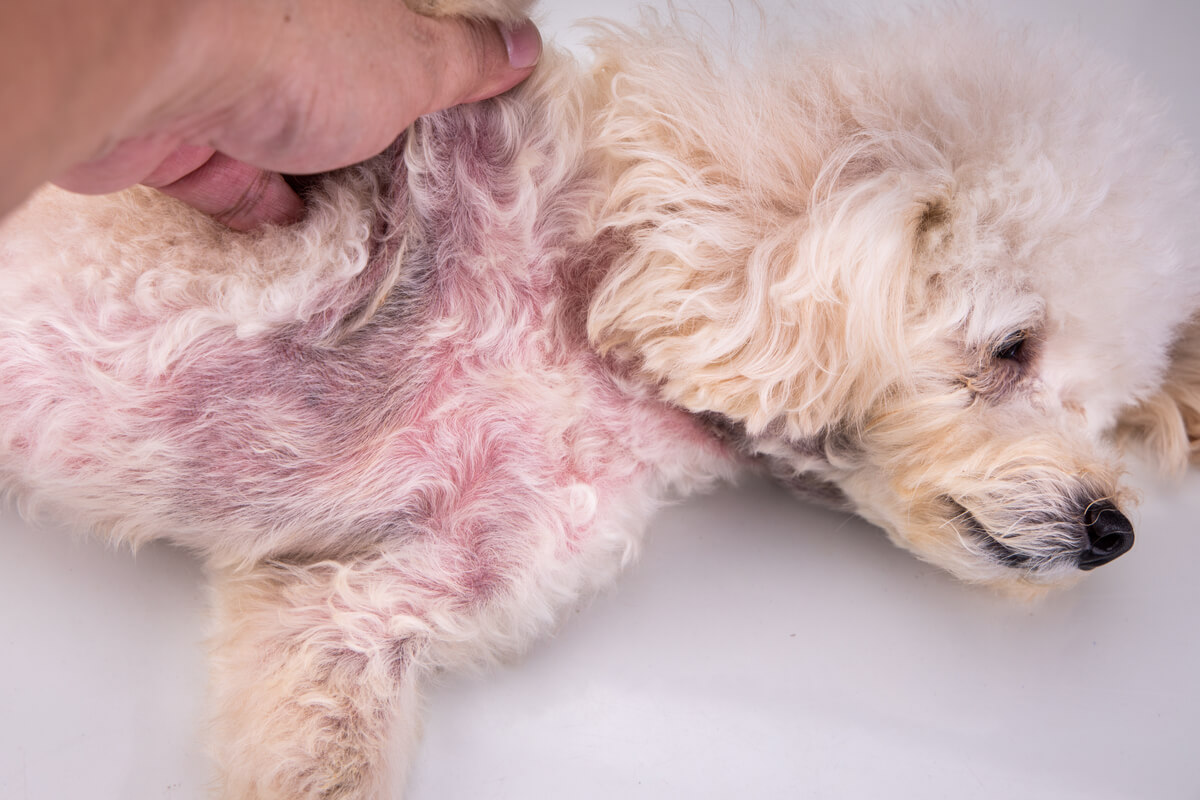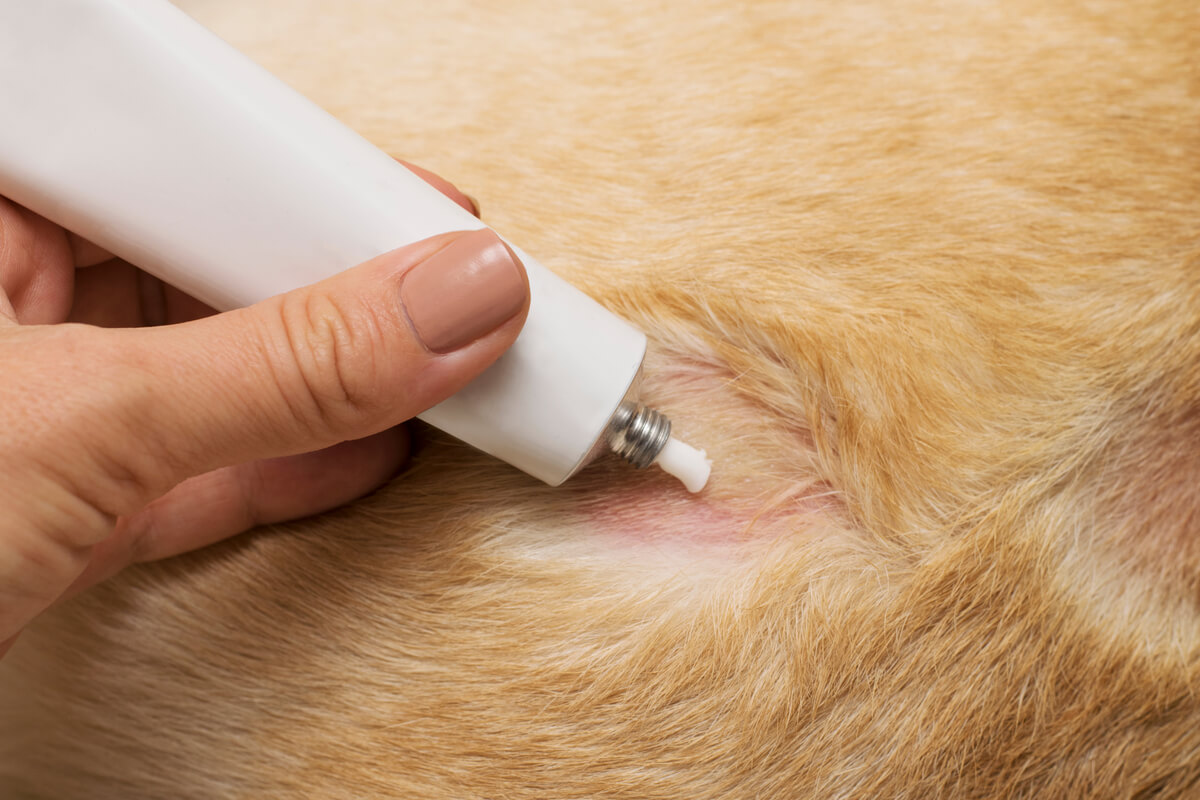Creams to Soothe Itching in Dogs


Written and verified by the biologist Ana Díaz Maqueda
Many dogs develop skin problems during their lifetime. One of the main causes of this annoying symptom in dogs are allergies. Occasionally, allergies are idiopathic or the tests are so expensive that they aren’t performed. For this reason, in many cases, symptomatic treatments are applied, i.e. only to soothe the itching in dogs.
In other cases, because the dog scratches the itchy areas continuously, wounds are often made that become infected over time. In these situations, before applying a topical treatment to soothe the itching, the animal should be treated with antibiotics.
On the other hand, good hygiene of the dog’s skin and the use of special shampoos help to control these itches. Here we’ll talk about the creams used to treat localized itching, both drugs and more natural therapies.
Antihistamine creams
For a treatment to be successful it’s very important to determine the underlying cause. Usually, if the source of the dog’s itching is not identified, it’s difficult to find an effective solution. This is because itching is a symptom and not a specific pathology.
However, in many cases, if the itching isn’t dealt with, the disease may not be cured. For this reason, some of the creams used to calm itching in dogs are those that contain antihistamines.
During allergic processes, the body releases histamine into the bloodstream. This substance can cause the itching that dogs feel, which is why such creams are used. However, the success of this treatment is highly variable and doesn’t work on all dogs.

Soothe itching in dogs with cyclosporine cream
An allergy is an overreaction of an organism’s immune system to substances that are not harmful or toxic. For this reason, sometimes a veterinarian may opt for immunosuppressive drugs, such as cyclosporine. This drug, added as an active substance to certain creams, isn’t one of the most commonly used in veterinary clinics.
It’s usually used in dogs suffering from contact allergies where the allergen isn’t yet known. The most common contact allergy in dogs is to grasses.
Glucocorticoid treatment for pruritus
Glucocorticoids are anti-inflammatory steroid drugs. They’re often considered to be the most effective medications for soothing itching in dogs. However, they don’t improve the disease, only its symptoms.
In addition, they often have side effects such as polyphagia, polydipsia, and polyuria, i.e. more hunger, more thirst, and increased urination respectively. They also suppress the function of the adrenal glands, which could increase the risk of diabetes and urinary pathologies. For this reason, the use of glucocorticoids in dogs suffering from obesity is usually very restricted.
Although glucocorticoids are usually administered as tablets, creams are also available. These can’t be used if the itching is caused by a skin infection, either primary or secondary.
Other natural creams to soothe itching in dogs
Of course, it isn’t only allergies and diseases that cause itching. Sometimes this symptom is caused by simple dry skin, which, in turn, is often caused by a diet poor in fatty acids. Low-quality feed is the main cause of this problem.
To determine if a dog has dry skin, it should first be checked by a veterinarian. If this is the case, several creams on the market moisturize the skin. However, the best solution is to change the dog’s diet to a higher quality feed, a more natural diet, or to use food supplements with fatty acids, such as salmon oil.

A veterinary problem
Finally, many dogs suffer from pruritus due to stress. These animals start scratching and, as their skin is damaged, it becomes itchier. Therefore, it’s essential to visit the veterinarian before administering any medication to a dog.
If, on the other hand, the dog could suffer from any allergy, it’s advisable to perform specific tests, because, even though they’re expensive, in the long run it’s more cost-effective and will improve the dog’s quality of life considerably.
Many dogs develop skin problems during their lifetime. One of the main causes of this annoying symptom in dogs are allergies. Occasionally, allergies are idiopathic or the tests are so expensive that they aren’t performed. For this reason, in many cases, symptomatic treatments are applied, i.e. only to soothe the itching in dogs.
In other cases, because the dog scratches the itchy areas continuously, wounds are often made that become infected over time. In these situations, before applying a topical treatment to soothe the itching, the animal should be treated with antibiotics.
On the other hand, good hygiene of the dog’s skin and the use of special shampoos help to control these itches. Here we’ll talk about the creams used to treat localized itching, both drugs and more natural therapies.
Antihistamine creams
For a treatment to be successful it’s very important to determine the underlying cause. Usually, if the source of the dog’s itching is not identified, it’s difficult to find an effective solution. This is because itching is a symptom and not a specific pathology.
However, in many cases, if the itching isn’t dealt with, the disease may not be cured. For this reason, some of the creams used to calm itching in dogs are those that contain antihistamines.
During allergic processes, the body releases histamine into the bloodstream. This substance can cause the itching that dogs feel, which is why such creams are used. However, the success of this treatment is highly variable and doesn’t work on all dogs.

Soothe itching in dogs with cyclosporine cream
An allergy is an overreaction of an organism’s immune system to substances that are not harmful or toxic. For this reason, sometimes a veterinarian may opt for immunosuppressive drugs, such as cyclosporine. This drug, added as an active substance to certain creams, isn’t one of the most commonly used in veterinary clinics.
It’s usually used in dogs suffering from contact allergies where the allergen isn’t yet known. The most common contact allergy in dogs is to grasses.
Glucocorticoid treatment for pruritus
Glucocorticoids are anti-inflammatory steroid drugs. They’re often considered to be the most effective medications for soothing itching in dogs. However, they don’t improve the disease, only its symptoms.
In addition, they often have side effects such as polyphagia, polydipsia, and polyuria, i.e. more hunger, more thirst, and increased urination respectively. They also suppress the function of the adrenal glands, which could increase the risk of diabetes and urinary pathologies. For this reason, the use of glucocorticoids in dogs suffering from obesity is usually very restricted.
Although glucocorticoids are usually administered as tablets, creams are also available. These can’t be used if the itching is caused by a skin infection, either primary or secondary.
Other natural creams to soothe itching in dogs
Of course, it isn’t only allergies and diseases that cause itching. Sometimes this symptom is caused by simple dry skin, which, in turn, is often caused by a diet poor in fatty acids. Low-quality feed is the main cause of this problem.
To determine if a dog has dry skin, it should first be checked by a veterinarian. If this is the case, several creams on the market moisturize the skin. However, the best solution is to change the dog’s diet to a higher quality feed, a more natural diet, or to use food supplements with fatty acids, such as salmon oil.

A veterinary problem
Finally, many dogs suffer from pruritus due to stress. These animals start scratching and, as their skin is damaged, it becomes itchier. Therefore, it’s essential to visit the veterinarian before administering any medication to a dog.
If, on the other hand, the dog could suffer from any allergy, it’s advisable to perform specific tests, because, even though they’re expensive, in the long run it’s more cost-effective and will improve the dog’s quality of life considerably.
All cited sources were thoroughly reviewed by our team to ensure their quality, reliability, currency, and validity. The bibliography of this article was considered reliable and of academic or scientific accuracy.
- Draelos, Z. D. (2011). A clinical evaluation of the comparable efficacy of hyaluronic acid‐based foam and ceramide‐containing emulsion cream in the treatment of mild‐to‐moderate atopic dermatitis. Journal of cosmetic dermatology, 10(3), 185-188.
- Fadok, V. A. Treating the Itch: The Importance of Breaking the Cycle World Small Animal Veterinary Association World Congress Proceedings, 2014.
- Hassan, H. Y., El-Sayed, M., Salah, M. A., & Zaghawa, A. (2004) EFFICACY OF ALOE VERA GEL LEAVES FOR TREATMENT OF SKIN AFFECTION AMONGE ANIMALS. II) TREATMENT TRIAL OF CALVES DERMATOPHYTOSIS. First Scientific Conference of Fac. Vet. Med.;Moshtohor.
- Gutiérrez Toro, C. (2013). Actualización en la neurofisiología del prurito y el nuevo enfoque terapéutico en el perro y el gato.
- Salinas, E. M., Rosales, M. D. L. L. M., & Estrada, X. Z. (2004). Caracterización histológica y ultraestructural de meningoencefalomielitis granulomatosa en dos perros. Veterinaria México, 35(4), 307-315.
- Jiménez Jusmet, S. (2022). Tratamientos tradicionales, actuales y terapias complementarias sobre el prurito en perros con dermatitis atópica. (Tesis de grado, Universidad de Lleida)
- Machicote, G. (2021). Guía Servet de Manejo Clínico. Prurito en perros y gatos: diagnóstico diferencial y manejo terapéutico. Grupo Asís Biomedia SL.
- Olivry, T., & Sousa, C. A. (2001). The ACVD task force on canine atopic dermatitis (XX): glucocorticoid pharmacotherapy. Veterinary Immunology and Immunopathology, 81(3-4), 317-322.
- Tejada, T., & Font, A. (2016). Diabetes mellitus en un perro tratado con ciclosporina. Clin. Vet. Peq. Anim, 36(3), 185-188.
This text is provided for informational purposes only and does not replace consultation with a professional. If in doubt, consult your specialist.








